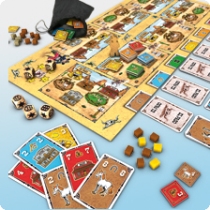Review: El Paso
Posted by James (admin) on November 23rd, 2009
 El Paso is a push-your-luck game where players are cowboys who are trying to loot towns and get away before the sheriff arrives. The players loot 7 towns one after the other. Each town contains loot tiles which each display one of 6 loot types (cattle, gambling, horse, cash, saloon, gold) and a number from 1 to 5. Each turn a player either commits to a turn of looting, or moves on to the next town.
El Paso is a push-your-luck game where players are cowboys who are trying to loot towns and get away before the sheriff arrives. The players loot 7 towns one after the other. Each town contains loot tiles which each display one of 6 loot types (cattle, gambling, horse, cash, saloon, gold) and a number from 1 to 5. Each turn a player either commits to a turn of looting, or moves on to the next town.
LOOTING
All players that decide to loot lay one of their cards face down – each card shows a type of loot and a number from 1 to 8 – and these show what loot each player will try to take. Then, the dice are rolled – each dice shows 2 cattle brands, 2 dice icons and 2 sheriff stars. If any sheriff stars are rolled, these dice are frozen for this town. If all 5 dice now show sheriff stars, the sheriff has arrived – any players who are looting are caught and must discard all loot tiles in their possession (victory points are unaffected). If the 5 dice do not all show sheriff stars, each player takes a single loot tile of the type that matches the card they played. If multiple players played cards of the same loot type then they select in card number order (highest first). Also, gambling and cattle tiles can only be taken if at least one dice shows the corresponding symbol. After taking tiles, players add a new card to their hand from any of the 6 face down draw piles.
The next round starts and the players choose again – loot or leave. Remember that any dice showing the sheriff star are frozen so fewer dice will get rolled each round as the sheriff stars accumulate and the likelihood of his arrival increases.
LEAVING TOWN
A player that leaves town can not loot it any more and is safe from the sheriff, but the number of tiles they can keep is limited to the number of players who have already left town. All other tiles must be exchanged for victory points – the exchange rate depends on the town, i.e. every 4 points on loot tiles can be exchanged for 1 victory point. Some towns have a 1:1 exchange rate for specific loot types.
When all players have left a town, or the sheriff arrives, or the town has been emptied of loot, the players move on to the next town. Each town has a different mix of loot types and the exchange rates for points improves too (adding a potential catch-up mechanic).
 OVERALL
OVERALL
We enjoyed El Paso as it was relatively simple but a lot of fun. It definitely had the “Do-I-or-Don’t-I” feeling of a good push your luck game. In addition to selecting when to leave town, the core gameplay is working out how to get the best out of your cards. Lower cards can be useful if you know you’ll get a decent tile no matter who goes for the same colour. There are other entertaining choices too: Do I loot cattle but risk getting nothing if a cattle icon isn’t rolled? Do I carry a high scoring tile to another town to get a better exchange rate but at the risk that the Sheriff will catch me first? Do I keep looting so that others leave town first so I can carry more tiles to the next town? Also, you can watch the discard piles to help inform you what cards other players may hold. The discard piles are never shuffled when they become a new draw pile, so potentially you could track when to grab a good card too.
One humorous rule is that, as you’re all cowboys, drawing new cards is not done in player order – it’s just whoever is quickest on the draw and grabs them first. Even though cards never run out, it was just instinctive to grab cards before the other players did – an interesting lesson in human behaviour.
There were only a couple of minor negatives. One was that the rules are written in a slightly odd order that doesn’t easily match the order of play and having the steps laid out chronologically would have helped; however, it didn’t take us long to understand them as they’re simple and relatively short. Also, the icons on the cards, dice and board could match slightly better – most are fine but the cattle brand on the dice isn’t instantly obvious it matches the cows on the tiles. Using the loot icons on the corresponding town buildings would have helped, as would colouring the exchange rate sign posts so it’s easy to see where the 1:1 exchange rates are at a glance.
But, these are very minor issues, as El Paso is a fun push-your-luck game with all the indecision (and groans when it all goes wrong) that you’d want and expect.
James
[Played with 3 players]

